Nine research projects focus on Long Island Sound marshes, water quality, public beaches
Contacts:
Robert Burg, Long Island Sound Study, E: rburg@longislandsoundstudy.net
Paul C. Focazio, Communications Manager, NYSG, E: paul.focazio@stonybrook.edu, P: (631) 632-6910
Judy Benson, Communications Coordinator, CTSG, E: judy.benson@uconn.edu, P: (860) 287-6426
Stony Brook, NY, March 2, 2023 — Long Island Sound water quality, salt marsh and public beach characteristics will be examined by marine and social scientists in nine research projects awarded funding by the Connecticut and New York Sea Grant programs (CTSG and NYSG respectively) and the U.S. Environmental Protection Agency’s Long Island Sound Study (LISS) Research Grant Program.
These new projects, which seek information that can be used to improve the conditions of the estuary for humans and wildlife, are being supported by $4.2 million in federal funds. That will be supplemented with matching funds of $2.1 million, for a total research package of more than $6.3 million.
The projects will be conducted over two years beginning this spring. The results will build on the substantial body of research funded through the LISS Research Grant Program administered by CTSG and NYSG since 2008 which has contributed to improved understanding and management of this nationally recognized estuary. Cumulatively, this represents the largest research investment in the Sound, which has been designated an estuary of national significance and one of the most valuable natural resources for both states.
The five NYSG-administered projects are:
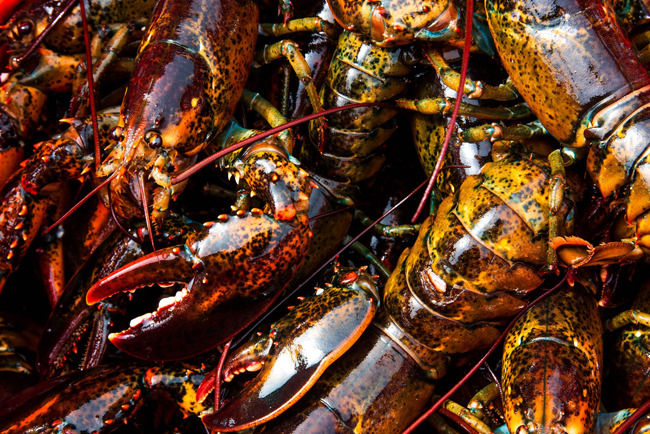
“We’ll be analyzing historical data to evaluate how cold- and warm-adapted fishes species have responded to climate-induced changes in Long Island Sound,” says Stony Brook University investigator Yong Chen. This includes such cold-water species as the American Lobster (pictured) and winter flounder and warm water species as blue crab and black sea bass. “This research will provide critical information to inform ecosystem management in the Sound." Credit: The Sea Grant American Lobster Initiative
• “Evaluating changes in suitable habitat and distribution of cold- and warm-adaptive fish species in a changing Long Island Sound to inform ecosystem-based management”
Led by Yong Chen of Stony Brook University, along with Kurt Gottschall of the Connecticut Department of Energy and Environmental Protection, Kim McKown, and John Maniscalco, at New York State Department of Environmental Conservation.
Conditions in the LIS have been shifting due to climate change, affecting water temperature, acidity, oxygen levels, and incidence of HABs. The scientists will evaluate these shifting conditions on the distributional changes of warm-adapted and cold-adapted species of fish in the Sound.
• “Coupled prediction of residential fertilizer use and nitrogen loads to Long Island Sound: An integrated targeting tool for nitrogen-reduction behavior change campaigns”
Led by Robert Johnston of Clark University, along with David Dickson and Jamie Vaudrey of the University of Connecticut, David Newburn of the University of Maryland, Qian Lei-Parent of the University of Connecticut, and Haoluan Wang of the University of Miami.
This project will use a survey of households to predict residential fertilizer lawn use for the coastal counties and municipalities across the LIS watershed. A model combining this information with water quality data will be used to inform prospective behavior-change campaigns to identify and prioritize the areas or types of households that would have the greatest impact on reducing nitrogen from lawn fertilizer and its impact on the Sound.
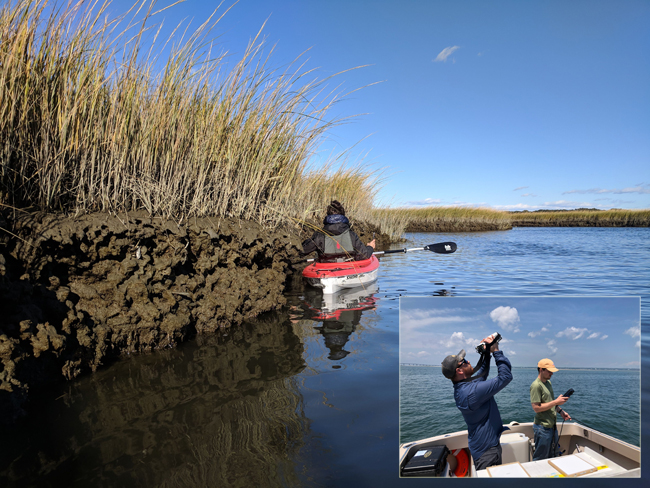
Team members of the Tzortziou lab collect measurements along Long Island Sound wetlands, near Wheeler Marsh, CT, as well as (Inset) optical measurements using sensor devices. Credit: Tzortziou Bio-Optics Lab
• “Actionable satellite water-quality data products in LIS for improved management and societal benefits”
Led by Maria Tzortziou of the City College of New York, along with Joaquim Goes of Columbia University and Melanie Abecassis of the University of Maryland College Park.
Human-caused climate change as well as other anthropogenic factors can intensify harmful algal blooms (HABs) in the LIS. Observations of the entire ecosystem, over different seasons and across a range of conditions, including during extreme weather events, can be obtained from satellite data. This work will provide actionable information for water resource management, policy, and decision-making.
• “Equitable access to Long Island Sound waterfront and beaches through on-demand mobility”
Led by Anil Yazici and Elizabeth Hewitt of Stony Brook University.
Some communities on Long Island do not have the mobility means to use and appreciate the LIS waterfront. Project leaders are designing and piloting on-demand shuttles that will facilitate equitable public access to the LIS waterfront. The team will survey users of the shuttle service to identify changes in attitudes toward the LIS environment.
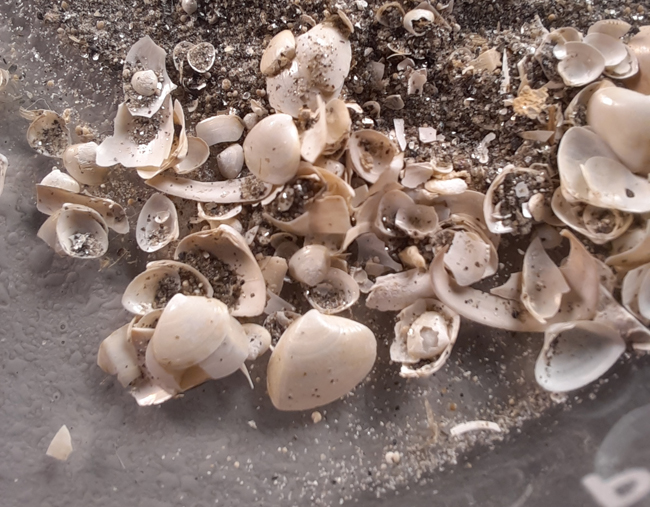
Mollusk shells from Long Island Sound. Dietl’s project will look at the remains of mollusks to understand past ecological conditions in the Sound. Credit: Matthew Pruden
• “Using geohistorical baselines to assess responses of benthic macroinvertebrate communities to the nitrogen TMDL management intervention in Long Island Sound”
Led by Gregory Dietl of the Paleontological Research Institution.
Scientists will look at the remains of mollusks buried beneath the seafloor to understand past ecological conditions in the Long Island Sound (LIS) . The molluscan geohistorical record could provide much-needed baseline information to assess the response of marine life to changes in water quality.
The four CTSG-administered projects are:
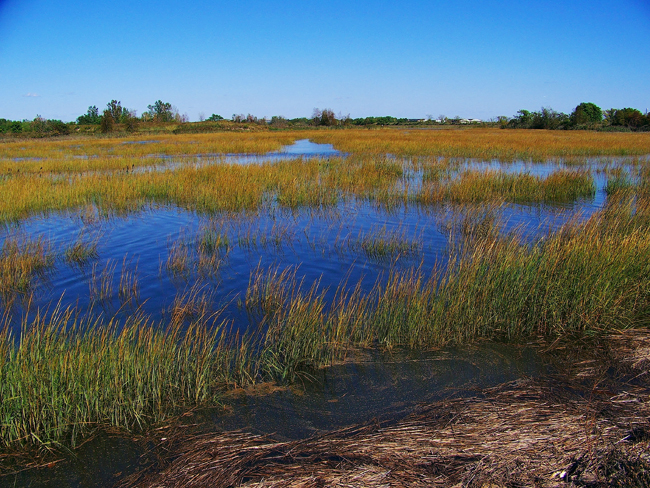
Great Meadows Marsh, a protected salt marsh in Stratford, CT. Credit: Courtesy of the town of Stratford
• “Testing the effects of vegetation on saltmarsh ecology, services and restoration success: from microbial ecology and biogeochemistry to wildlife conservation”
Led by UConn professors Christopher Elphick, Beth Lawrence and Ashley Helton, along with Blaire Steven of the CT Agricultural Experiment Station and Min Huang of the CT Department of Energy and Environmental Protection.
By creating sediment mounds of varying elevations planted with various species at different densities at Great Meadow Marsh in Stratford, the researchers seek to develop an interdisciplinary understanding of how marsh restoration efforts impact the functioning of these ecosystems and their value for wildlife.
• “Assessing the impacts of warming and planting strategy on the resilience of restored salt marshes to improve restoration efficacy”
Led by Sarah Crosby of The Maritime Aquarium at Norwalk, along with A. Randall Hughes and Nicole Kollars of Northeastern University, Nicole Spiller of Harbor Watch and Earthplace, and LaTina Steele at Sacred Heart University.
By enclosing sections of salt marshes within open chambers to increase interior temperatures, the researchers will assess the expected effects of warmer temperatures associated with climate change. The work will include plantings of southern-sourced marsh grass (Spartina) strains to determine impacts on future resilience, and an examination of the genetic mixing of these salt marsh strains to enhance the success of restoration efforts.
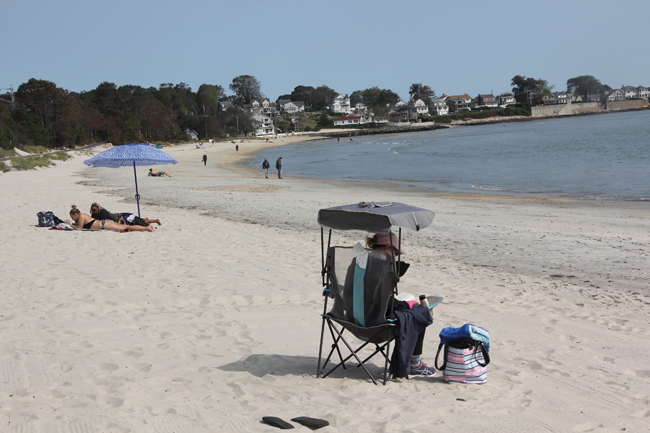
Rocky Neck State Park, a public beach in East Lyme, CT. Credit: Judy Benson/CTSG
• “Tracking pathogen pathways and fecal bacteria patterns for public beaches suffering with poor water quality grades and closures”
Led by UConn Professor Michael Whitney with Peter Linderoth of Save the Sound.
The researchers will analyze patterns of fecal indicator bacteria in water samples from Green Harbor Beach in New London and Rocky Neck State Park in East Lyme. Because of high bacteria levels, these two public beaches are among the most frequently closed or under swim advisories in the state of Connecticut. The work will include efforts to identify bacteria pathways and public outreach about water quality issues.
• “Assessing temperature mediation of PFAS impacts on coastal fish fitness to inform environmental management”
Led by professors Maria Rodgers of North Carolina State University and Jessica Brand, Daniel Bolnick, Kat Milligan-McClellan and Milton Levin of UConn.
The researchers will examine concentrations of PFAS (poly- and per-fluoroalkyl substances) at different water temperatures in fish populations downstream from the outfalls of public sewage treatment plants. The results will quantify how fish can be expected to respond to exposure to these “forever chemicals” in the Sound over the next five decades.
In Their Words: Long Island Sound Research Projects
• From Sylvain De Guise, director of CTSG: “The continued partnership between Sea Grant programs and EPA will support a nice diversity of innovative and ambitious research projects to benefit both people and ecosystems of Long Island Sound, for mutual benefits—a wise investment, in my opinion.”
• From Syma Ebbin, research coordinator for CTSG: “This competition was the largest ever administered, allowing the program to support these diverse, high-quality proposals, all with the capacity to enhance Long Island Sound’s management, health and public benefits.”
• From Becky Shuford, director of NYSG: "New York Sea Grant is proud to continue this long-standing partnership with Connecticut Sea Grant and the EPA Long Island Sound Study. This year was the largest research competition to date resulting in the selection of nine excellent and diverse studies that will address priorities related to historical and current water quality conditions, habitat and fisheries health and restoration, and Sound access. The results will have a direct benefit to the communities, coasts, critters, and waters of the Long Island Sound Estuary.”
• From Lane Smith, research coordinator for NYSG: “This cohort of new research will build on the growing legacy of impactful research that benefits the Long Island Sound and its coastal communities. This continues the fruitful partnership between Sea Grant and the EPA Long Island Sound Study that benefits the LIS ecosystem.”
• From David W. Cash, EPA New England regional administrator: “The Long Island Sound estuary is an essential ecosystem that supports communities, economies, and habitats across the region. I’m pleased to say these diverse and innovative Sea Grant projects include a focus on improving the Sound’s water quality, mitigating the effects of climate change, and helping local communities receive more equitable access to the Sound.”
• From Lisa F. Garcia, EPA Region 2 regional administrator: “The Long Island Sound is in the center of one of the most densely populated coastlines in the country. This investment will help Long Island Sound communities combat sources of pollution that lead to closing public beaches or contaminating local fish. It will also help communities improve efforts to restore wetland habitat and increase resiliency to climate change by understanding the effects of sea level rise and warming temperatures on valuable marsh habitats. This funding will advance ecological research and play a critical role in improving water quality and reducing pollution, providing lasting results for the wildlife and wetlands in the Sound for years to come.”
More Info: Long Island Sound Study
Long Island Sound is one of the 28 nationally designated estuaries under the National Estuary Program (NEP), which was established by Congress in 1987 to improve the quality of Long Island Sound and other places where rivers meet the sea.
The Long Island Sound Study is a cooperative effort involving researchers, regulators, user groups and other concerned organizations and individuals, and is led by the Environmental Protection Agency and the states of New York and Connecticut.
In recent years, LISS has experienced a period of rapid expansion attributed to the increased federal funding for the program, and to implement actions, objectives, and goals established under a Comprehensive Conservation and Management Plan. The increase is grounded in the CCMP’s four overarching themes: Clean Waters and Healthy Watersheds, Thriving Habitats and Abundant Wildlife, Sustainable and Resilient Communities, and Sound Science and Inclusive Management. Resilience to climate change, long-term sustainability, and environmental justice, are principles that connect to all four of the themes.
For more on what you can do to make a difference, click over to the "Get Involved" or "Stewardship" sections of the LISS's website. News on the LISS can also be found in NYSG's related archives.
More Info: Connecticut Sea Grant
Connecticut Sea Grant (CTSG), located at the UConn Avery Point campus, is a state and federal partnership funded by the National Oceanic and Atmospheric Administration (NOAA) and the University of Connecticut. CTSG, which in 2019 celebrated its 30th anniversary as a Sea Grant College Program, works to achieve thriving coastal and marine ecosystems and communities by supporting local and national research, outreach and education programs. CTSG accomplishes this by providing objective, science-based information to encourage individuals and organizations to make informed decisions, communicating scientific findings in a practical manner helpful to diverse audiences, and helping others balance the use and conservation of coastal ecosystems. Ultimately CTSG’s activities increase the resilience of the coastal communities, economies and ecosystems.
The program has three foci: research, outreach, and education. Outreach efforts include the CTSG Extension Program, and its Communications Program. The program also has an administrative staff committed to promoting understanding of the Sea Grant mission.
For more, visit seagrant.uconn.edu.
More Info: New York Sea Grant
New York Sea Grant (NYSG), a cooperative program of Cornell University
and the State University of New York (SUNY), is one of 34 university-based
programs under the National Oceanic and Atmospheric Administration’s
National Sea Grant College Program.
Since 1971, NYSG has represented a statewide network of integrated
research, education and extension services promoting coastal community
economic vitality, environmental sustainability and citizen awareness
and understanding about the State’s marine and Great Lakes resources.
Through NYSG’s efforts, the combined talents of university scientists
and extension specialists help develop and transfer science-based
information to many coastal user groups—businesses and industries,
federal, state and local government decision-makers and agency managers,
educators, the media and the interested public.
The program maintains Great Lakes offices at Cornell University, SUNY
Buffalo, SUNY Oswego and the Wayne County Cooperative Extension office
in Newark. In the State's marine waters, NYSG has offices at Stony Brook
University in Long Island, Brooklyn College and Cornell Cooperative
Extension in NYC and Kingston in the Hudson Valley.
For updates on Sea Grant activities: www.nyseagrant.org has RSS, Facebook, Twitter, Instagram, and YouTube links. NYSG offers a free e-list sign up via www.nyseagrant.org/nycoastlines for its flagship publication, NY Coastlines/Currents, which is published quarterly.